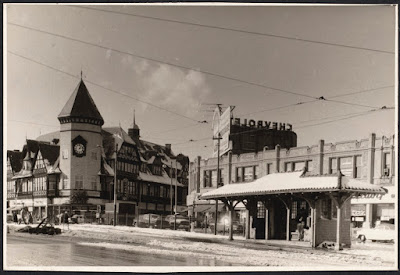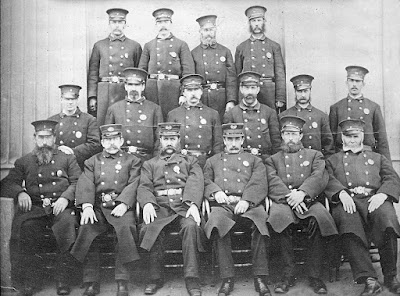Financially-ailing Wheelock College is looking for a buyer (according to
news reports) for the Victorian house at 295 Kent Street that has served as home to the college's presidents since 1963. I decided to look into the history of the house and, as is often the case, my research led in unexpected directions.
 |
| 295 Kent Street |
The house, built around 1872, has had only three owners. Wheelock purchased it from the estate of hotel executive J. Linfield Damon who lived there from 1901 until his death at the age of 95 in 1963.
But it was the original owner of the house, S. Dana Hayes, whose story proved the most interesting. The house was built for him and remained in his family from the time of its construction until its sale to Damon in 1901. But Hayes himself disappeared under mysterious circumstances in 1880 and was never heard from again.
 |
| Boston Globe headline, January 30, 1880. |
Samuel Dana Hayes, who went by S. Dana, was born in Roxbury in 1840. His father, Augustus Allen Hayes, was a chemist and one of Massachusetts state assayers of ores and minerals. The younger Hayes studied at his father's alma mater, Norwich University in Vermont, although he did not graduate, and by the 1860s had followed in his father's footsteps as a chemist and state assayer.
The state assayer's office was established by the legislature in 1846. Assayers — there could be more than one — were to certify the chemical composition of ores and metals submitted to them. They were to be paid "a reasonable compensation by the person securing such assay to be made." Assayers were later given the added responsibility of ensuring that "spirituous and intoxicating liquors [were] of a pure quality, and unadulterated with any mixture, or noxious or poisonous substance."
Hayes quickly established a reputation as one of the leading assayers in the country. He lectured and wrote on chemical properties, testified in court cases (including cases of suspected poisoning) and developed a successful private business certifying the composition of a wide variety of products, including:
- baking powder
- mineral water and ginger ale
- vinegar
- yeast
- cocoa
- whiskey
- lager beer
- skin care treatments ("The Queen's Toilet")
- mineral oil
- fertilizer
- cookware and silverware
Advertisements for many of these products in newspapers across the country included endorsements from Hayes, usually noting his official role as a Massachusetts state assayer.
 |
| Newspaper ads with product endorsements from S. Dana Hayes. Left to right: Pearl Baking Powder, in the Black Hills Weekly Pioneer, Deadwood, South Dakota; Gaff, Fleischmann & Co. Yeast (yes, it's that Fleischmann's Yeast) in the Boston Post; and Heublein's Lager Beer in the Hartford Courant. (Click image for a larger view.) |
One ad, for Hall's Vegetable Sicilian Hair Renewer, noted:
When a discoverer of any scientific subject, asks the co-operation of the learned in science, to test the merit and truth of his discovery by severe tests and practical results, and then to indorse [sic] and recommend it, it is fair to presume it is valuable for the purpose intended. Such has been the course pursued by Mess'rs. Hall & Co., proprietors of Hall's Vegetable Sicilian Hair Renewer. And all those who have tested it (among whom we may mention Dr. A.A. Hayes and S. Dana Hayes, Chemists and State Assayers of Massachusetts ... assert it is the best preparation in use for all cutaneous diseases of the scalp.
Hayes had married a Scottish woman, Margaret Gibson, in Scotland in 1860. In 1877, few years after moving into the Kent Street home, they adopted a little girl. Three years later, in January 1880, Hayes left Boston for New York and attended to some business for a law firm in a patent infringement case. That was the last time he was seen or heard from.
Both the
Boston Globe and the
New York Times reported two weeks later that before disappearing Hayes had made a careful examination of his business, paid all his debts, arranged for his wife to have power of attorney, and left her a note saying he would not be returning but that she would be informed of his whereabouts in the event of his death.
Friends and acquaintances, including his brother, attributed the odd behavior to a temporary "aberration of mind", perhaps brought on by the death of his mother a few months earlier. Business troubles were dismissed as a possible cause, as his business was in good shape. They expected to hear from him shortly. The
Globe correspondent, however, reported that "domestic troubles are really at the bottom of the matter." In any case, he did not return.
Margaret Hayes placed an ad in the New York Herald in August 1881 looking for word of her husband. (It was reproduced in the
Boston Globe.) In the ad, which the Globe titled "Where Is S. Dana Hayes?", she noted that he had "gone West in April last" so perhaps she had obtained additional information since his disappearance 19 months earlier. But there was no new news.
 |
| Boston Globe, August 4, 1881 |
Hayes' father Augustus died in June 1882. His will left one third of his estate to S. Dana and his heirs, provided he came forward (or was proved dead) within three months. Otherwise his share would be divided equally between his brother and sister. The family placed a personal notice in a New York paper, reproduced in the
Boston Post, urging him to come forward but there is no record of him having responded.
 |
| Boston Post, September 14, 1882 |
Margaret Hayes lived in the Kent Street house on and off until selling it in 1901. (She rented it out and lived elsewhere in Brookline when not living there.) She died some time after 1910. The Hayes' adopted daughter, Hope Beatrice Hayes, graduated from Smith College in 1899, married a florist, and was a school teacher in Pittsfield, Newton, and Pelham, New Hampshire. She died in 1929 at the age of 54.
Product advertisements citing Hayes' stamp of approval continued to appear periodically for years. An ad in the
Washington Post
for the Forest Glen resort in North Conway, New Hampshire promoting
"the purest water in New Hampshire" noted that "S. Dana Hayes, State
Chemist of Massachusetts, said this is a remarkably pure and excellent
water." That was in 1906, more than a quarter century after Hayes
disappeared.






































